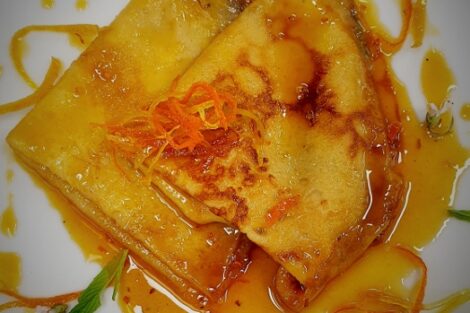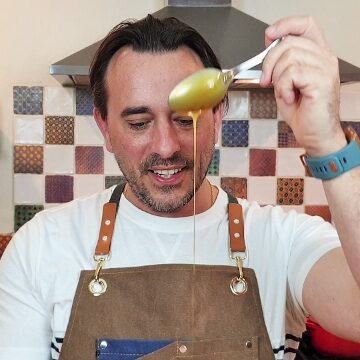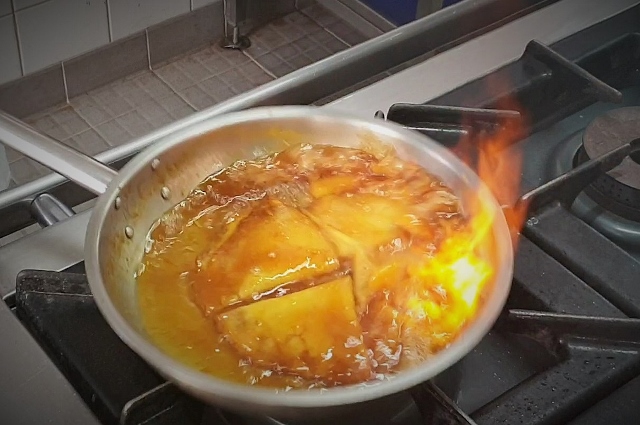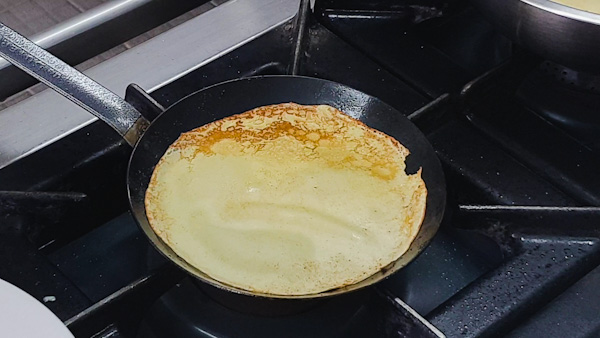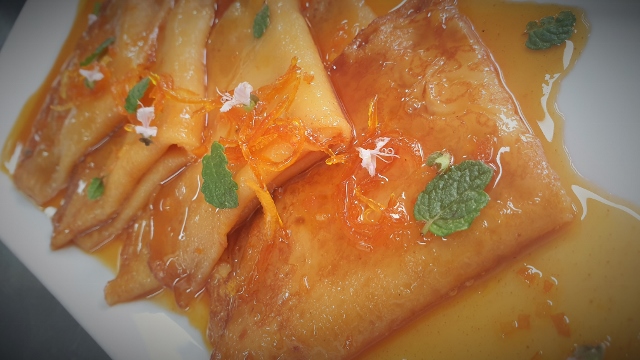Hello foodies,
This recipe is inspired from the south coast of France. Monaco is a beautiful place between France and Italy, often known for the grand prix F1 and the place of the rich and famous. What you may not know is that the Crepes suzette were invented there in Monte-Carlo in 1896.
Crepes originally from Brittany, are described as a thin, flat round pancake. It is traditionally made on a flat, round hot tray the we call “une Crepiere”. Let me tell you, it takes a fine art to make a crepe on one of theses hot flat tray. Crepes are sold in restaurant or corner shop. I recommend you find out yourself and sit in an old “Creperie” where the building has a soul and the smell take you on a journey.
The legend says that the Head chef of the “Grand Hotel” Mr. Auguste Escoffier was cooking for the future King Edourd the VII, prince of Wales. The latest was in company of a lady named Suzanne Reichenberg. Chef Escoffier created the dish made of crepes cooked in a buttery caramel with “Mandarines” and flambed with Curacao. The Future king loved the dish and wanted to thank Chef Escoffier. The chef wanted to named the dish after Edouard the VII. However, the future king said “Thank you for the honour but I would rather you give it the name of this exquisite lady in my company”. The name of the dish was born “Crepes Suzette” ….
I am glad this happened and travel the centuries as it sounds much better than “Crepes King Edourd VII” hahahahah
To access the full recipe and video, click the link below:
The Origin of Crepes:
The story of the crepe started around the 12th and 13th century in Brittany. The crepe was made with buckwheat flour. Rich in fiber and protein grain, mixed with water was the beginning to create a batter. A bit like a flat bread. People used to cook it on a flat tray over a wood fire and a bit of butter.
In medieval times, peasants presented crepes to their feudal lords as a demonstration of loyalty. In the Breton town of Quimper they actually have a museum celebrating the history of crepes
It is only in the 20th century that the crepe, as we know it, found a lot more interest with the development of white flour (La farine de froment).
The crepe was brought to America in the 1930s by French Chef Henri Charpentier. He claimed to have been the one to create and serve the original “Crepe Suzette” to the future King Edward VII in Monte Carlo. While this point has been disputed, there is no denying that this classic dish and its delicious orange sauce soon became the staple feature of haute cuisine in America.
Crepe’s Legend & Superstition:
Crepes are not just an easy, cheap and delicious food. Crepes have a cultural significance and a dedicated day on the French calendar. French people Celebrate the national crepe day on the 2nd of February. It is called “La chandeleur”.
Historically known as the Virgin Mary’s Blessing Day, in France is now known as le jour de la crepe (the day of crepe), and it has become a familial day of gathering, more than a religious celebration. La Chandeleur (the return of the light), the date commemorates the winter’s decline and the coming light of the spring. Families gather and celebrate this moment with a meal of crepes (savoury and or sweet).
According to legend, and my mother is a big believer of that. As a kid and even nowadays, you must hold a coin in your writing hand and a frying pan in your other, flip a crepe and it lands flat back on the pan, you will be prosperous all year.
Bon Appetit
Frenchy
Ingredients
-
Crepe batter
- Suzette sauce
- Garnish
Instructions
-
Making the crepes
-
Measure all your ingredients
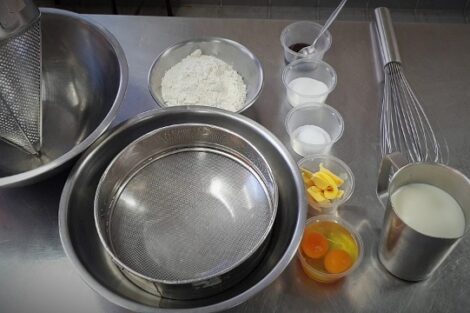
-
Using a sieve, sift your flour in a large bowl
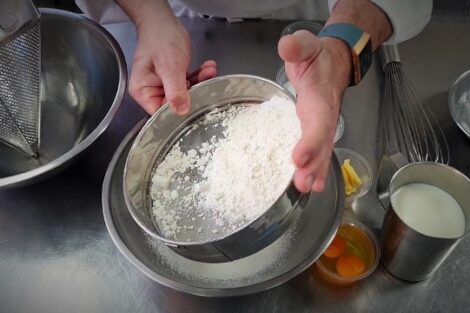
-
Add the sugar
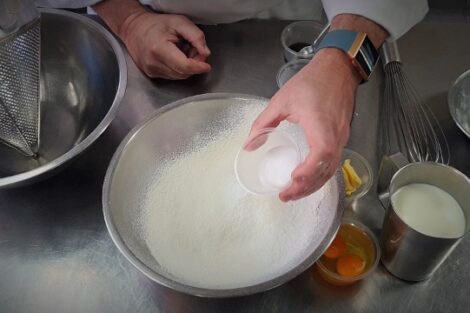
-
Add the salt
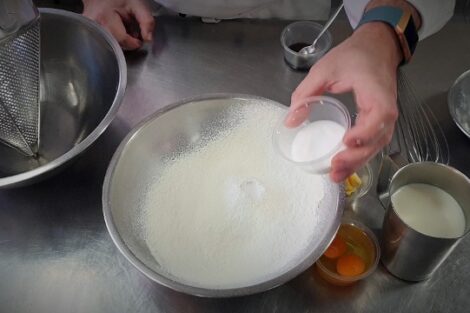
-
Give it a quick mix and create a well (mix all the dry ingredients basically)

-
Add your eggs with the milk and cream

-
Add the vanilla paste
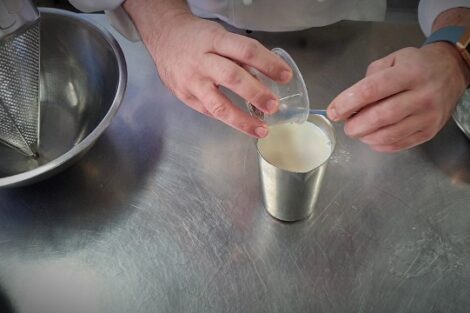
-
Using a whisk, give it a good mix
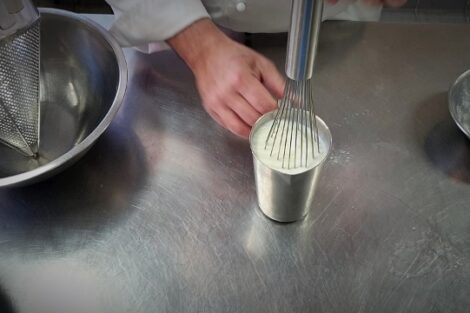
-
Using the whisk, slowly incorporate the liquids to the dry ingredients
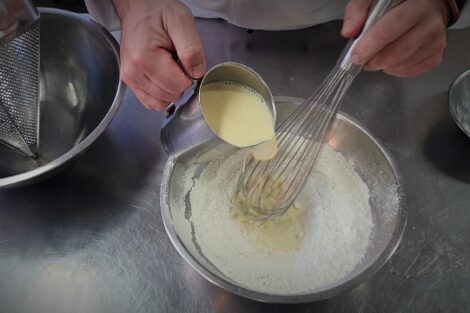
-
As you are whisking, keep adding more milk
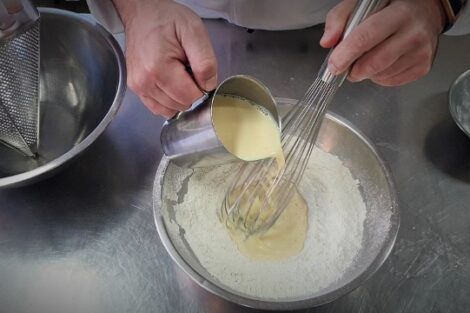
-
Keep whisking in the liquid ingredients
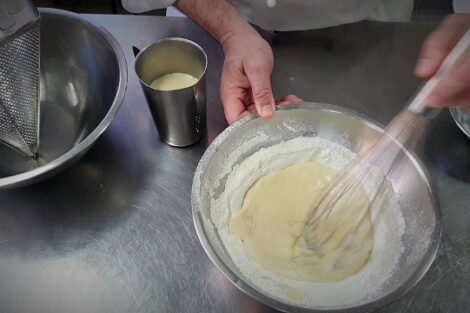
-
Add more and be gentle to not create any lumps
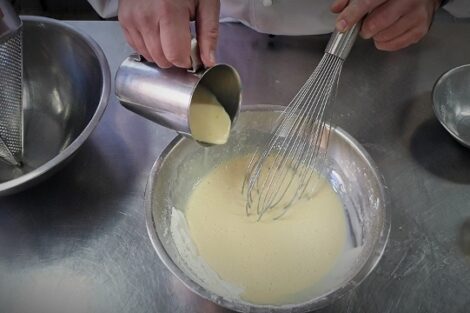
-
Once you have all your ingredients combined together, pass the crepe batter through a fine sieve or conical strainer (chinois). Cover and let the crepe batter rest for 30 minutes at least.
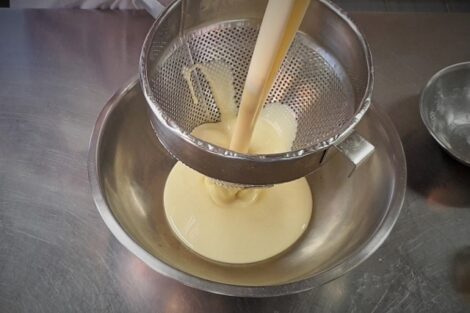 Suzette sauce ingredients
Suzette sauce ingredients
-
Whilst your batter is resting, you can prepare your ingredients for the suzette sauce. Peel your orange to keep the zest of 1 ornge with little or no white skin (It is bitter)
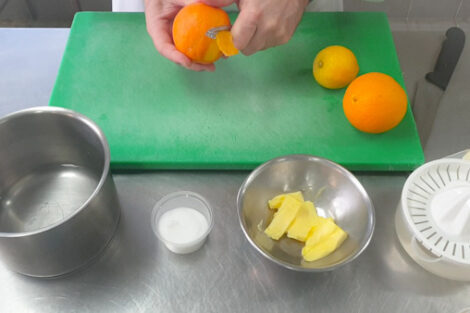
-
Do the same for your lemon. As you can see my butter is on my bench at room temperature to soften.

-
Once you are done peeling, cut your zest of citrus fruit into a julienne (thin strips of zest).
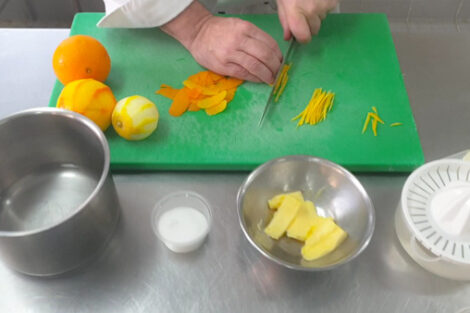
-
Just like that. If you are not familiar with this cut, just use a zester as i do not want you to cut your fingers :)
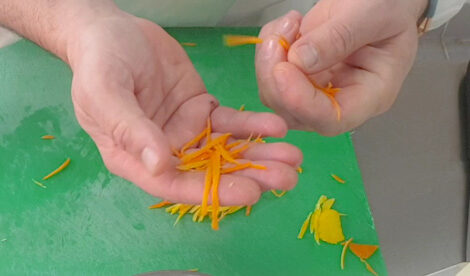
-
In a sauce pan, add 100 ml of water
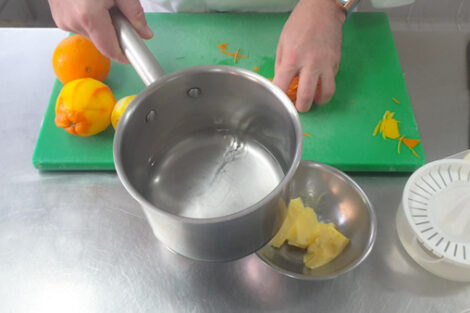
-
Add your zest julienne to the water and bring it to a boiling motion.
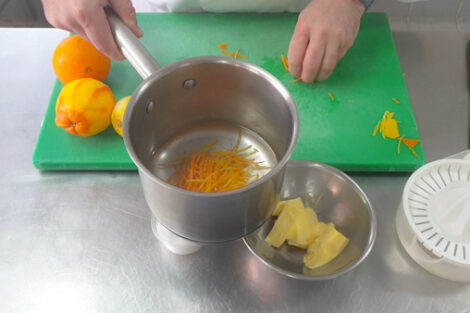
-
Make sure it boils for a minute. This is called blanching. It reduce the level of bitterness to the zest and make the citrus zest exquisite

-
Whilst your zest are blanching, you have the to juice both oranges and 1/2 of lemon. Keep the juice aside for the sauce later.
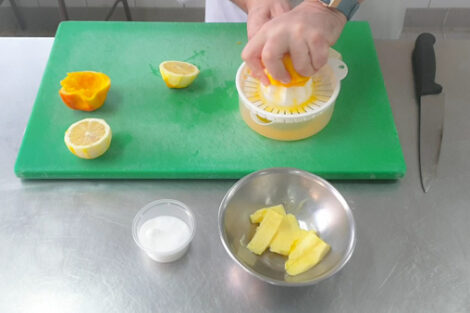
-
Once it has boiled, strain your zest.

-
and keep them in a bowl to cool down.
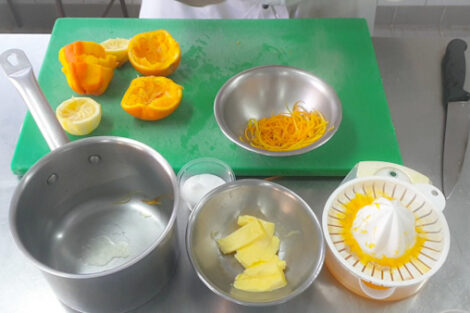 Confit the zest
Confit the zest
-
Add 50g of water in the sauce pan
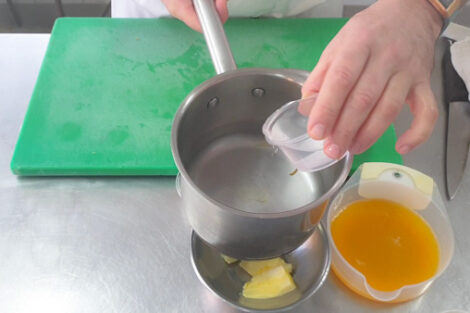
-
Add 50g of sugar to the water.
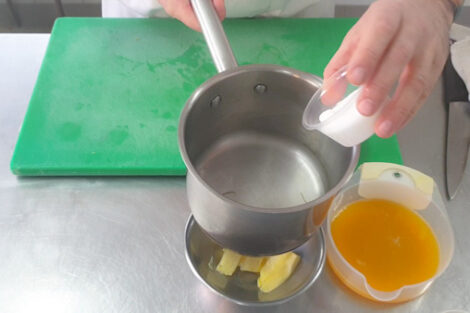
-
Add half of your zest to the sauce pan and bringing to a boil. Once it boils just reduce the heat and let it simmer until it becomes syrupy and your zest looks translucent
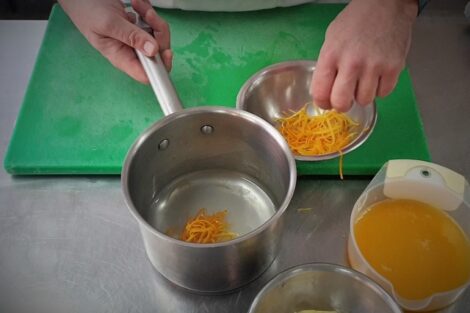
-
Once it boils just reduce the heat and let it simmer until it becomes syrupy and your zest looks translucent

-
Keep the zest and the syrup in a small container to cool down. Try one they are delicious
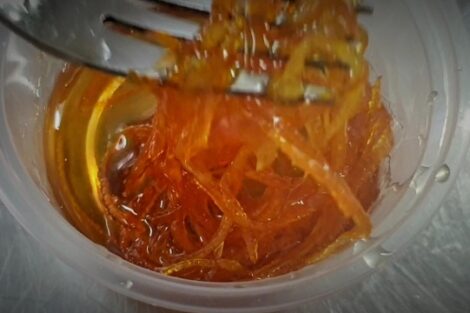 Citrus Butter
Citrus Butter
-
Chop the other half of zest in small dice.
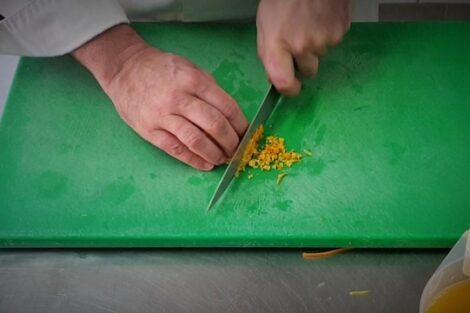
-
Check that your butter is soft like a cream consistency
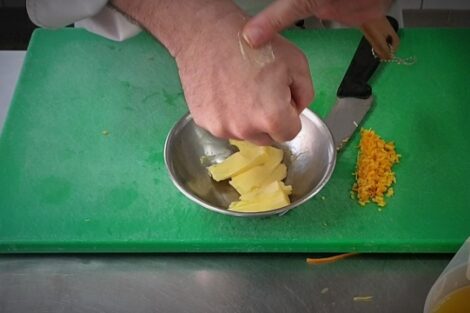
-
Soften your butter a little more with a spatula if needed.
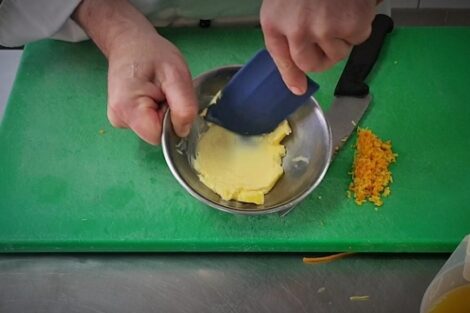
-
Add your diced zest
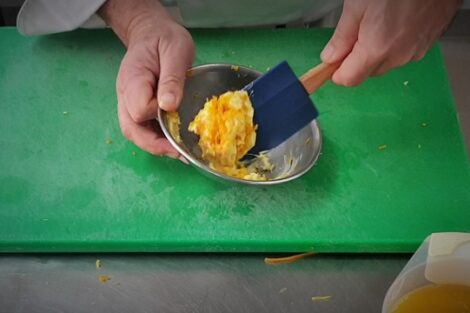
-
Mix it all very well and keep aside on your table. by now your garnish and citrus butter are ready and it is time to cook the crepes
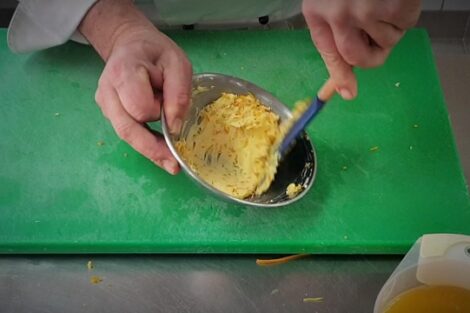 Seasoning a pan-If you are using an old iron pan
Seasoning a pan-If you are using an old iron pan
-
Iron crepe or omelette pan can look clean but still be a little dirty. Heat up the pan on high heat.

-
Add some salt to the pan and heat it up for a minute. turn of the heat.
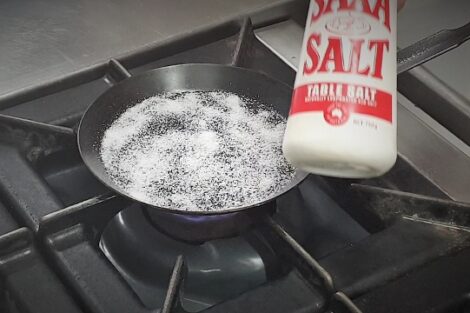
-
With few layers of paper towel, scrub the pan with the salt and be careful to not burn yourself. The salt helps exfoliating the pan and remove all impurities.
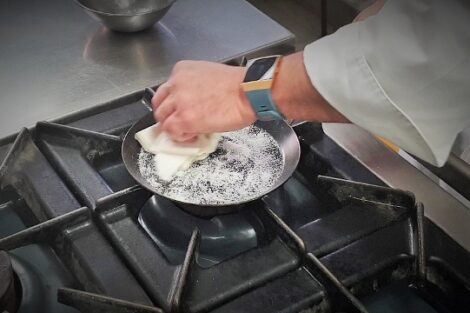 Now we are ready to cook the crepes.
Now we are ready to cook the crepes.
-
Using your clean pan, turn on the heat and melt the butter needed for your crepe batter ( the plain butter)

-
Melt the butter until it becomes foamy a little brown.
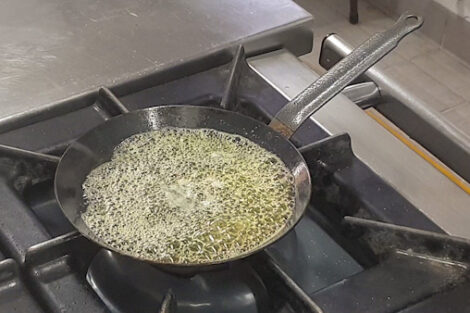
-
Add your butter to the crepe batter

-
Whisking well and keep your crepe pan on a medium heat.

-
Using a small laddle, poor a little bit of the batter in the crepe pan and spread the batter by using a circular motion as you pour the liquid batter. It takes a bit of practice but by the third crepe you will get it and make very thin crepes.
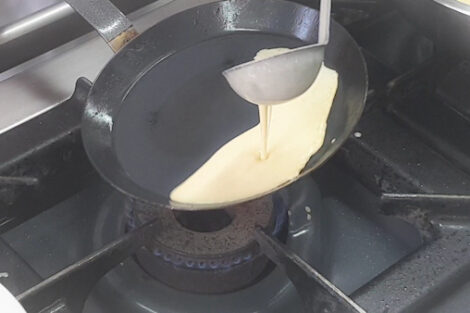
-
The crepe will take between 45 seconds and a minute to cook. you know the crepe is ready to be flipped when you do not see any more wet patches on top
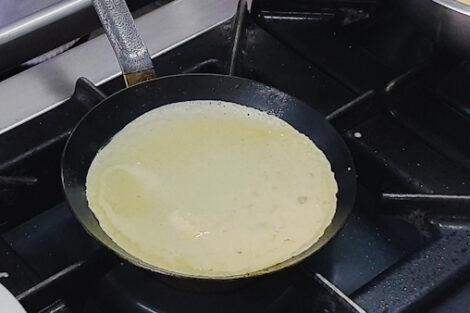
-
Using a spatula, gently lift the crepe and slide the spatula under the crepe and flip it upside down.
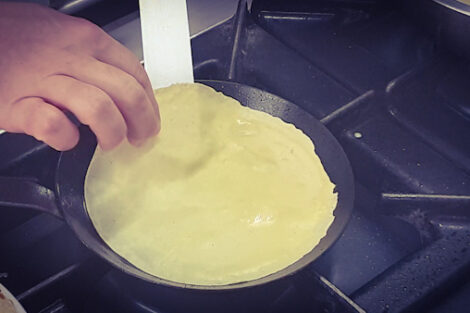
-
Cook for another minute and place your crepe on a plate. Keep going until you have cooked all the crepes.
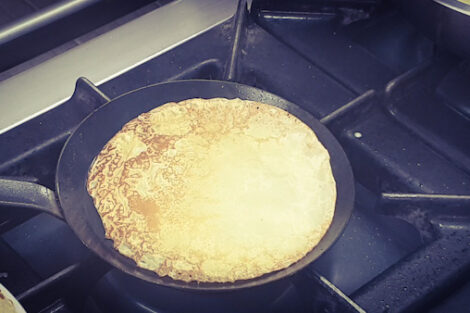
-
Once they are all cooked, fold your crepes into 4 to create a triangle.
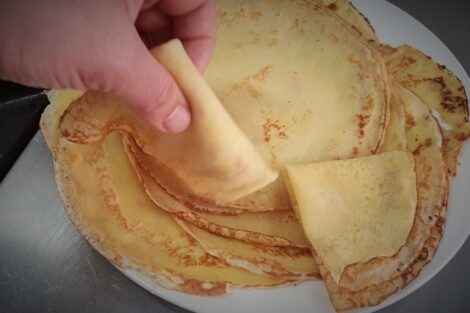 Finally the crepes suzette
Finally the crepes suzette
-
Heat up a large fry pan

-
Add 1/3 rd of the sugar in the pan and let it slowly melt. yes you are correct just like that.
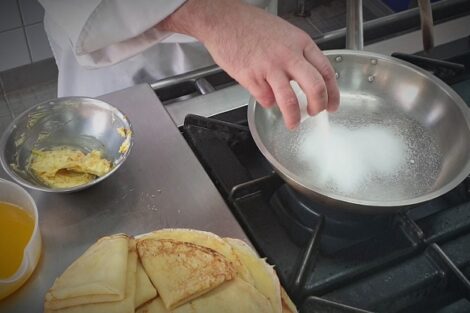
-
add a little more sugar and melt it. stir a little bit to not burn it. We are making a dry caramel.
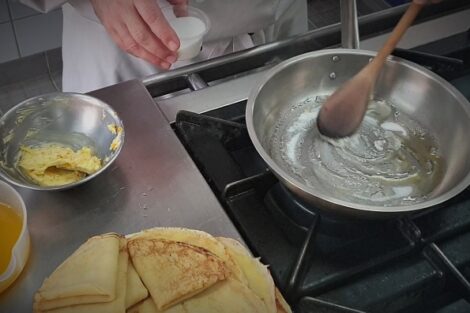
-
Add the last third and keep melting it until you have a light brown colour, amber like a caramel
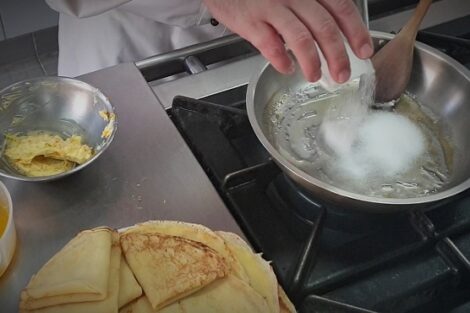
-
See that caramel colour?
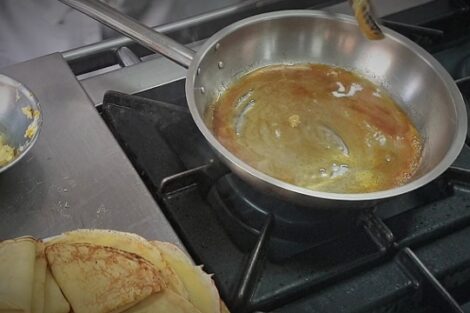
-
Add your citrus butter. it will go all pschhhhttt foamy
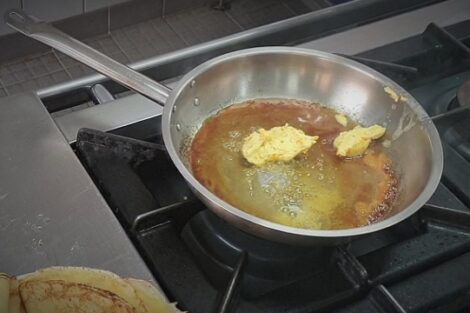
-
Stir it quickly.
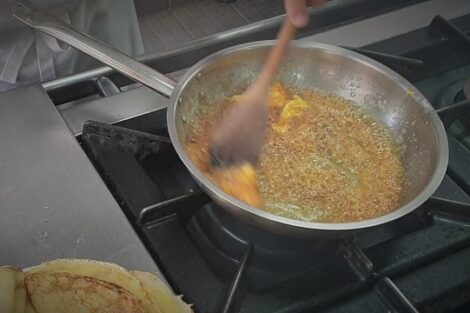
-
Add your orange and lime juice. be careful of the steam coming up
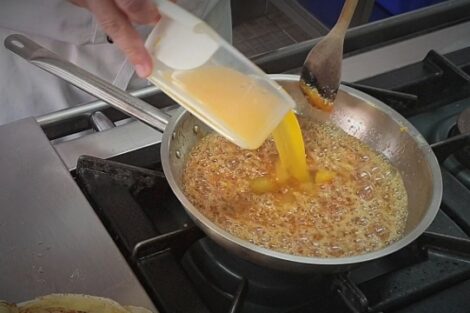
-
Reduce the heat and let it simmer for 5 minutes (reducing=it concentrate the flavours)

-
Once the juice as evaporated by half, Add your crepes to the frying pan
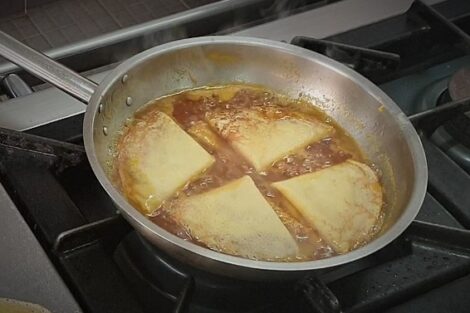
-
After one minute, flip them to the other side. The crepes will suck up a little bit of the sauce which make them just DIVINE
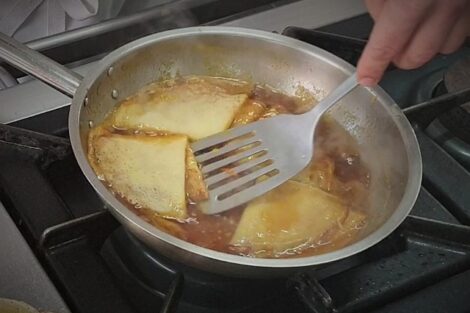
-
Let them cook for a minute on this side and place the border of the pan in the middle of your gas burner. Here we are creating a strong heating point
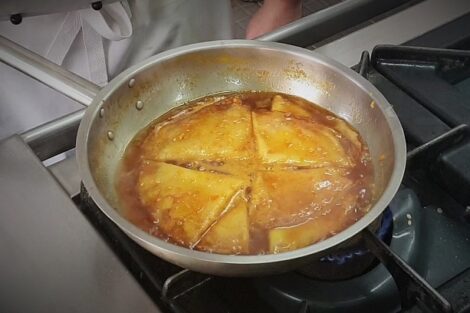
-
After 10 seconds pour in all your Grand Marnier at once. Be careful of the flame
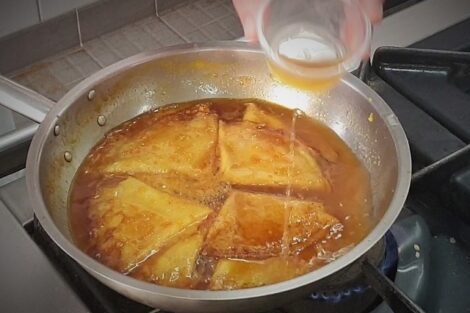
-
Check the pan and the flambed, flame happens. shut down the heat and let the alcohol burn. Remove the pan from the heat.
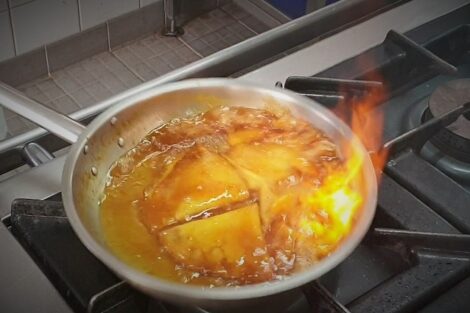
-
Place your crepes on a warm plate

-
Add more of the sauce onto the crepes

-
Add your confit zest
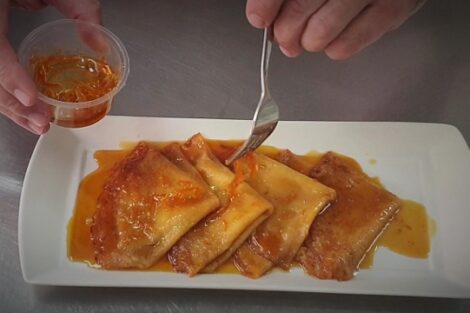
-
Add few mint leaves and edible flowers if you want. You can serve one or 2 crepes per personwith a little vanilla ice cream if you wish
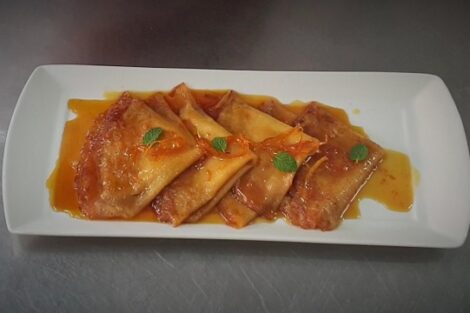
-
Voila, Crepes Suzette.
